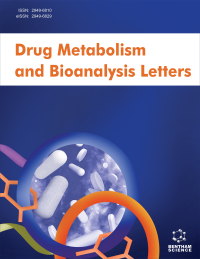- Home
- A-Z Publications
- Drug Metabolism and Bioanalysis Letters
- Previous Issues
- Volume 16, Issue 1, 2023
Drug Metabolism and Bioanalysis Letters - Volume 16, Issue 1, 2023
Volume 16, Issue 1, 2023
-
-
s Colonic Degradation as Reverse Process to Flavone Biosynthesis in Plants: Similarities and Differences
More LessBy Katrin SakBackground: For many years, it was thought that the main function of the colon is the reabsorption of water and salt and the elimination of unused food materials. Only very recently, a crucial role of the human intestinal microbiota in the metabolism of different food constituents, including plant foods-derived flavonoids, was discovered. Currently, the knowledge about colonic degradation of ingested flavonoids, involved bacteria Read More
-
-
-
Potential Polymorphic CYP1A2 and CYP2D6-mediated Pharmacokinetic Interactions between Risperidone or Olanzapine and Selected Drugs Intended to Treat COVID-19
More LessRisperidone/olanzapine are antipsychotics used in Peru to control symptoms of psychosis. The objective was to review the available evidence on potential pharmacokinetic interactions mediated by CYP1A2 and CYP2D6 polymorphic genes between risperidone or olanzapine and selected drugs for the treatment of COVID-19. A bibliographic search was conducted in SciELO and PubMed/Medline. The selection criteria included all t Read More
-
-
-
CYP2D6 and CYP2C19 Genes Associated with Tricontinental and Latin American Ancestry of Peruvians
More LessPrecision medicine seeks to individualize the dose from the beginning of pharmacological therapy based on the characteristics of each patient, genes involved in the metabolic phenotype, ethnicity or miscegenation, with the purpose to minimize adverse effects and optimize drug efficacy. The objective was to review studies that describe the association of the CYP2D6 and CYP2C19 genes with the tricontinental and Latin A Read More
-
-
-
Bigels; A Charismatic Drug Delivery Formulation
More LessAuthors: Manu Singhai and Sankha BhattacharyaBigels are a novel concept in contrast to previous gel formulations. To look like one gel, bigels are made by merging two gel phases at high shear rates. Colloidal gels can be the same (as in water-in-water bigels, which are phase-separated systems), the same but different, or a combination of a hydrogel and an oleogel. These colloidal gels are utilized to construct bigels (oleogel-in-hydrogel bigels or hydrogel-in-oleogel bigels). B Read More
-
-
-
Biological Potential and Pharmacological Activity of Columbianetin in Chronic Diseases
More LessAuthors: Dinesh K. Patel and Kanika PatelBackground: Herbal medicine is widely used in different systems of traditional and complementary medicine. People believe that herbal medicines are safe and more cost-effective than other synthetic medicines. Herbal medicines are also used as a promising source of new drug discovery molecules in modern medicines. Coumarins are polyphenols class phytochemical that naturally occurs in higher plants and are used in Read More
-
-
-
Simultaneous Determination of 16-Hydroxystrychnine and Demethylbrucine by LC-MS/MS in Rat Urine and Its Application to Pharmacokinetic Study
More LessAuthors: Rui Yan, Bin Xia and Shan ZhangIntroduction: This paper aimed to establish a method to help investigate the combination mechanism of traditional Chinese medicine from the metabolic perspective. Background: Semen Strychni has been a frequently used herb in clinics for a long time. In traditional Chinese medical science, Semen Strychni always combinate with other herbs to modulate its nature of severe toxicity. However, the mechanism of the c Read More
-
-
-
Determination of Olmesartan in Bulk and Pharmaceutical Dosage Forms through the Development and Validation of Stability-indicating RP-HPLC Method
More LessAuthors: Akshita A. Agrawal, Jagdish K. Sahu, Shilpa Dawre and Abhishek KanugoBackground: Angiotensin II type 1 (AT 1) receptor antagonist (angiotensin receptor blocker (ARB) called Olmesartan medoxomil (OLM) prevents angiotensin II from acting on the renin-angiotensin-aldosterone pathway, which is a crucial factor in the development of hypertension. OLM is reported to rapidly hydrolyze into its active metabolite, Olmesartan, in plasma after oral treatment. Objective: The objective of the ongo Read More
-
Volumes & issues
Most Read This Month
Article
content/journals/dmbl
Journal
10
5
false
en


